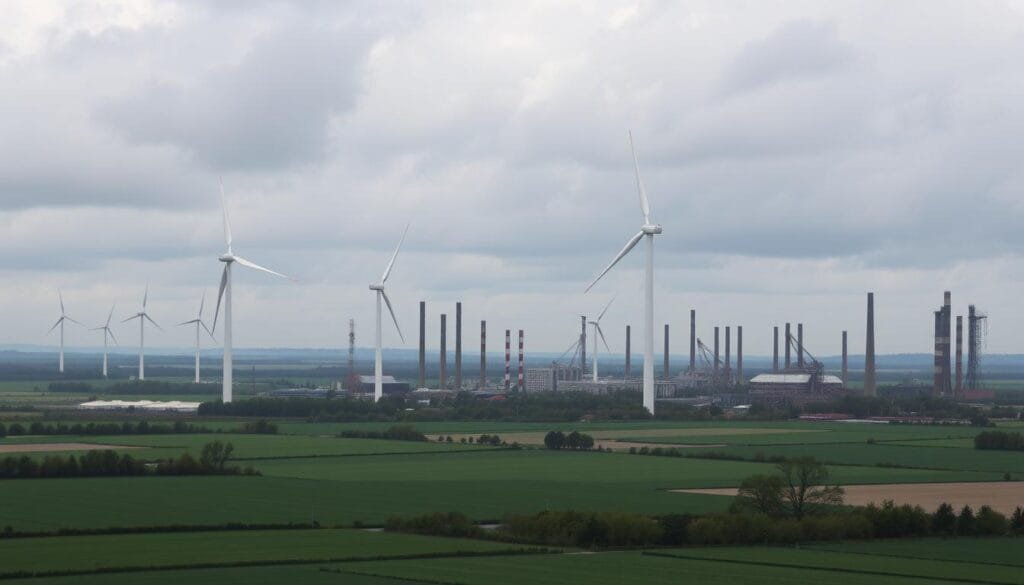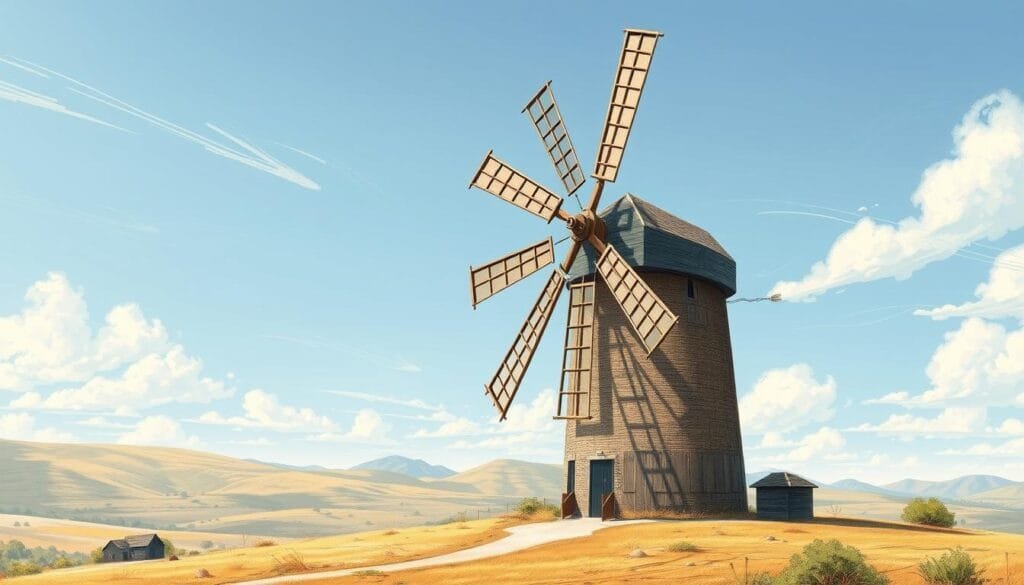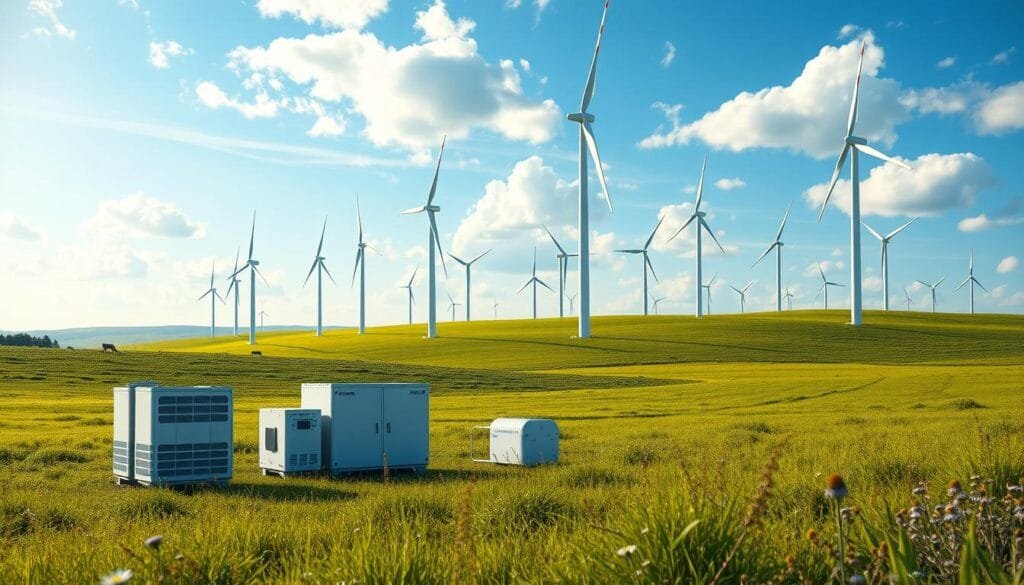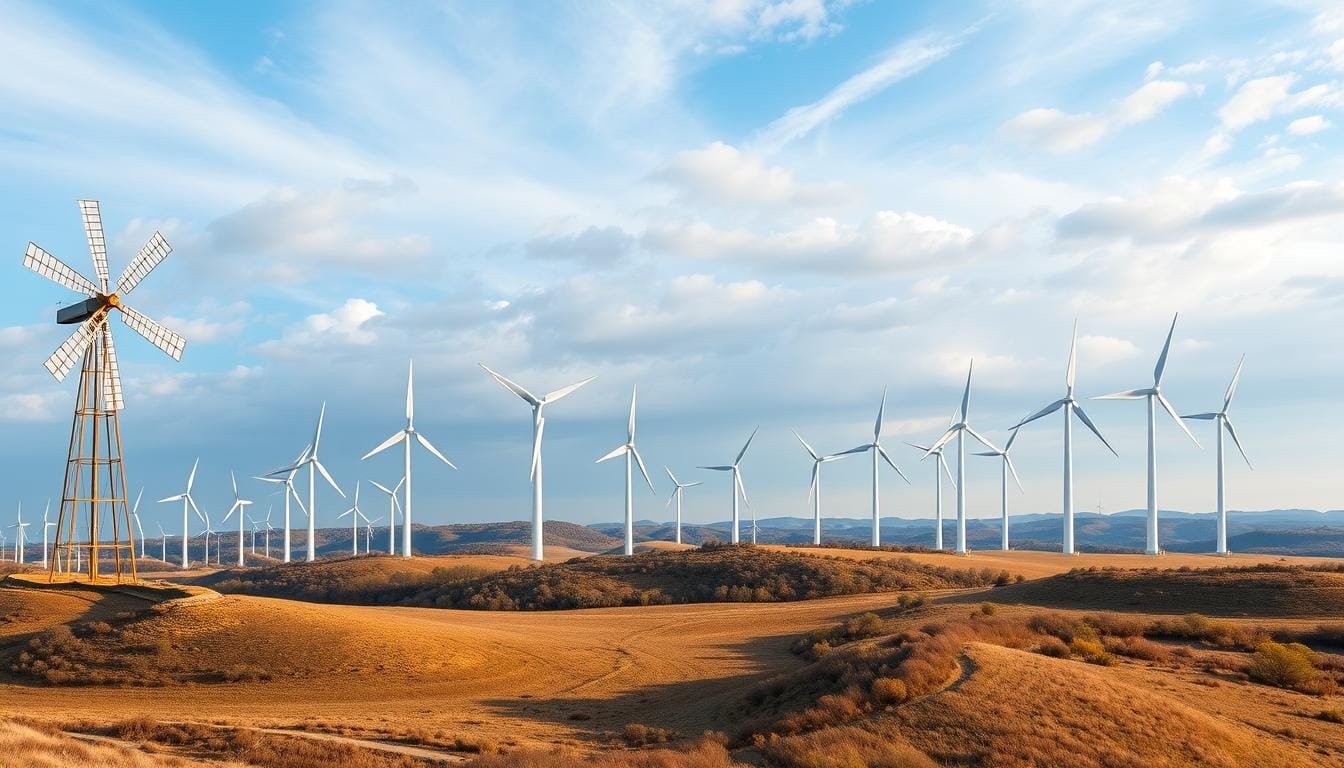Imagine a technology that’s been around for 5,000 years but is now changing our energy use. The story of wind turbines is a long and exciting one. It goes from ancient sailboats on the Nile to today’s big wind farms.
Wind energy’s history shows how creative humans have always been. People first used wind power thousands of years ago. They used it for sailing, farming, and simple tasks before electricity was invented.
Today, wind turbines are much more advanced. They’ve changed from simple tools to powerful machines. These machines can now power thousands of homes with clean energy.
Key Takeaways
- Wind energy technology spans over 7,000 years of human history
- Early applications included sailing, water pumping, and grain milling
- Wind turbines have evolved from simple mechanical devices to sophisticated electricity generators
- The technology continues to play a critical role in global renewable energy strategies
- Modern wind turbines represent a sophisticated blend of engineering and environmental sustainability
Ancient Origins of Wind Power Technology
Wind power is one of humanity’s earliest and most clever inventions. The history of wind turbines goes back thousands of years. It shows how ancient people used natural energy in creative ways.
Early Sailing and Navigation
The first use of wind energy was in sailing. Ancient sailors found ways to use wind to travel. They developed advanced sailing techniques that changed trade and exploration worldwide.
- Earliest wind-powered vessels developed in Mediterranean regions
- Sailing ships used tall masts to capture wind effectively
- Wind navigation enabled long-distance maritime trade routes
First Mechanical Applications
Early wind turbine inventions showed great engineering skill. In Persia (modern-day Iran), people built some of the first windmills between 500-900 AD. These windmills were early examples of using wind energy for mechanical tasks.
| Region | Time Period | Wind Power Innovation |
|---|---|---|
| Persia | 500-900 AD | First documented windmills |
| China | 13th Century | Windmill designs based on Persian models |
Hero of Alexandria’s Wind-Powered Inventions
Greek engineer Hero of Alexandria made big steps in wind power technology. His wind-driven wheel was one of the first ideas to use wind to power machines.
“The ability to transform natural wind into mechanical energy marks a pivot moment in human technological innovation.” – Ancient Engineering Historians
These early beginnings of wind turbines were key for later tech advancements. They show our ability to solve problems with renewable energy.
The Rise of Windmills in the Middle East
The Middle East saw a big step forward in wind turbines in the early medieval times. By the 9th century, new wind power ideas came up in Iran, Afghanistan, and Pakistan. These ideas changed how people farmed and managed water.
These Panemone windmills were a big deal in wind energy tech. They had unique designs with:
- Long vertical driveshafts
- Six to twelve rectangular sails
- Sails made of reed matting or cloth
“The windmill was not just a machine, but a technological marvel that revolutionized agricultural productivity in the Middle East.” – Wind Energy Historians
These early windmills were mainly used for important farming tasks, like:
- Grinding grain
- Pumping water
- Helping with irrigation
| Region | Windmill Characteristics | Primary Use |
|---|---|---|
| Sistan (Modern Iran) | Horizontal design | Water pumping |
| Afghanistan | Reed-covered sails | Grain processing |
| Central Asia | Vertical driveshafts | Agricultural support |
These early windmills set the stage for more wind power progress. They spread tech knowledge across Central Asia. This later influenced European windmill designs in the centuries that followed.
Medieval European Windmill Development
The medieval era in Europe saw a big change with the rise of wind technology. By around 1300 AD, windmills started changing how people farmed and worked. These early wind turbines were a huge step forward in technology.
Dutch Innovation in Wind Power
The Netherlands became a top name in windmill tech during the medieval times. Dutch engineers made advanced wind-powered systems that changed their land. By the 15th century, the first polder windmill appeared, helping manage water in low areas.
- Over 1,000 windmills operated in Holland province
- Windmills mainly pumped water to keep reclaimed land dry
- Nearly 50% of Dutch land sits just above sea level
British Windmill Engineering
British engineers also made big strides in windmill design. They worked on making windmills more efficient and useful. Their efforts boosted farming in rural areas.
Agricultural Applications
Medieval windmills did more than just manage water. They were key for:
- Grinding grain
- Pumping water
- Processing agricultural products
- Helping local economies grow
“The windmill represents humanity’s first true mastery of environmental energy transformation” – Medieval Engineering Scholars
These wind tech breakthroughs paved the way for later energy innovations. They showed how medieval societies tackled tough tech challenges with creative solutions.
The History of Wind Turbines Through the Industrial Revolution

The Industrial Revolution was a complex time for wind energy. Steam and coal power were big, but wind power kept improving. Windmills, important for farming and small industries, had to adapt during this era.
By 1850, the Netherlands had 9,000 windmills. This showed how vital wind power was for local economies. Wind-powered mills were key for sawmills, paper making, and farming.
“The adaptability of wind technology proved resilient even as new energy sources emerged.”
- Wind power was vital for rural areas
- Despite steam power, wind tech kept improving
- Windmills were used in farming and small industries
Steam power changed how windmills were used. Windmills found it hard to compete with steam’s power. By the 1700s, windmills were less important.
| Year | Wind Power Milestone | Location |
|---|---|---|
| 1850 | Peak of Windmill Usage | Netherlands |
| 1887 | First Electricity-Generating Windmill | Scotland |
| 1900 | Windmill Count | Denmark: 2,500 |
Even with challenges, the foundation for modern wind energy was laid. The first electricity-generating wind turbine was built in 1887. This marked the start of today’s advanced wind energy systems.
Pioneering Electric Wind Power Generation
The late 19th century was a game-changer for wind turbines. Inventors turned traditional wind power into a new way to make electricity. This change would forever alter how we produce energy.
Two engineers stood out during this time. They were key in creating new wind turbine designs.
James Blyth’s Electrical Breakthrough
In July 1887, James Blyth from Scotland made the first electricity-generating wind turbine. His invention was a big step in wind power history. It showed how wind could be turned into electricity.
Charles Brush’s Engineering Marvel
After Blyth, Charles F. Brush built an even better turbine in Cleveland, Ohio. His design was impressive with:
- A massive 17-meter rotor diameter
- An 18-meter supporting tower
- 12-kilowatt electricity generation capacity
Early Commercial Success
These early turbines opened doors to new ways of making electricity. Brush’s turbine was a big step forward. It showed wind energy could power large-scale electricity production.
“The future of energy lies not in burning resources, but in harnessing the power of nature.” – Charles F. Brush
Blyth and Brush’s work started the journey to today’s wind energy systems. They changed how we see renewable electricity.
The Halladay Windmill Revolution

In 1854, Daniel Halladay changed the game with his new windmill design. He teamed up with businessman John Burnham to start the U.S. Wind Engine & Pump Company in Illinois. Their windmill was a game-changer for farming in the American West.
Halladay’s windmill was special for many reasons:
- Automatic wind direction adjustment
- Consistent sail speed maintenance
- Self-regulation for up to six months
- Water pumping from depths of 28 feet
At just $50 per windmill (with an additional $25 for pumps and pipes), Halladay’s invention became accessible to farmers and ranchers. It could work in winds as low as 11 mph, perfect for the Western plains and prairie.
“A windmill that works without constant human intervention is not just a tool, but a revolution in agricultural technology.” – Industrial Innovation Journal
The market loved it. By the 1870s, nearly 400 companies were making windmills. By 1930, there were about 600,000 windmills in use. Halladay’s work set the stage for more green energy breakthroughs.
| Windmill Specification | Details |
|---|---|
| Wind Wheel Diameter | 10 feet |
| Initial Cost | $50 |
| Operational Wind Speed | 11-18 mph |
The Halladay Windmill Company lasted until 1863. But its impact lived on through companies like Aermotor. Aermotor made over 20,000 windmills every year in the early 1900s.
Wind Power Development in the Early 20th Century
The early 20th century was a key time for wind power. It saw big technical leaps and more uses in business. These changes changed how people thought about making energy from wind.
Technical Innovations Driving Wind Power
Wind turbine tech made huge strides during this time. Important advances included:
- Improved aerodynamic blade designs
- More efficient electrical generation systems
- Enhanced material technologies
Commercial Scale Applications
The early 20th century saw big steps in using wind power for real needs. In 1931, a wind turbine in Yalta showed its power:
- Power output: 100 kW
- Mast height: 30 meters
- Grid voltage: 6.3 kV
“Wind power was transitioning from experimental technology to a viable energy solution.” – Energy Historian
By 1920, Albert Betz shared a key idea. He said wind turbines could reach a top efficiency of 59.26%. This idea was key for wind power’s future.
Emerging Energy Landscape
These milestones were important for future green energy. Small wind plants started for homes and farms. Bigger ones looked into joining the power grid.
The Impact of World War II on Wind Technology
World War II was a turning point for wind technology. It led to new ways to make energy, as engineers looked for alternative sources. They worked hard to find new solutions.
The Smith-Putnam wind turbine was a big step forward. It was built on “Grandpa’s Knob” near Rutland, Vermont. This turbine marked a key moment in wind energy history.
“Innovation emerges from challenges, and wartime was a catalyst for wind energy research.” – Energy Historian
Important changes happened during this time:
- Advanced aerodynamic research
- Improved materials science
- Enhanced understanding of energy generation
The Smith-Putnam turbine was impressive for its era:
| Feature | Specification |
|---|---|
| Blade Diameter | 53 meters (175 feet) |
| Power Generation | 1.25 megawatts |
| Location | Rutland, Vermont |
Though it faced challenges, the turbine was a big step forward. The war’s focus on innovation helped pave the way for better wind power in the future.
The 1970s Energy Crisis and Wind Power Renaissance
The 1970s were a turning point for wind energy. The global oil crisis made countries look for new ways to make energy. They started to focus on alternative energy sources quickly.
This decade saw big changes in energy. Denmark and the U.S. started big programs to use less oil. They wanted to make their own energy.
Government Initiatives
Lawmakers played a big role in helping wind energy grow. The U.S. Congress passed the Public Utility Regulatory Policies Act (PURPA) in 1978. It helped renewable energy a lot:
- Mandated utilities to buy power from small renewable generators
- Offered money to help with wind energy projects
- Made it easier to connect renewable energy to the grid
Technological Breakthroughs
There were big steps forward in wind power tech during this time. People working in the field made turbines better and more efficient.
“The energy crisis taught us that innovation is our greatest resource” – Anonymous Energy Researcher
| Year | Milestone | Significance |
|---|---|---|
| 1979 | Tvindkraft Wind Turbine | World’s largest turbine, 53 meters high |
| 1980 | First U.S. Utility-Scale Wind Farm | Altamont Pass, California |
| 1991 | Vindeby Offshore Wind Farm | World’s first offshore wind installation |
These big steps helped make wind energy important today. It went from being a small idea to a key part of making power worldwide.
Modern Wind Farm Development

Wind farm technology has changed a lot from the 1980s. Now, we have more efficient and powerful wind power systems. This is thanks to many wind energy milestones.
Some key changes in modern wind farm technology include:
- Increased turbine size and capacity
- Advanced wind farm management systems
- Improved energy conversion efficiency
- Reduced production costs
By 2023, the world’s wind power capacity hit over 1,000 gigawatts. This shows how fast the industry has grown. Modern horizontal-axis wind turbines (HAWTs) now convert between 33% to 50% of kinetic wind energy into electrical energy. This is a big jump from older designs.
| Wind Farm Development Milestone | Year | Significance |
|---|---|---|
| First US Wind Farm | 1980s | 20 turbines generating 600 kW |
| Hywind Floating Wind Farm | 2017 | First commercial floating wind farm with 5 turbines |
| Global Wind Power Capacity | 2023 | Over 1,000 GW installed worldwide |
“Wind power has become one of the lowest-cost sources of electricity, often cheaper than new fossil fuel plants.” – Global Energy Research Institute
The growth of wind farm technology shows big steps in technology, cost, and green energy.
Offshore Wind Power Evolution
The offshore wind power sector is a key step in wind technology. It came after land-based wind farms hit their limits. Engineers and researchers then looked into the ocean’s wind energy.
The first offshore wind farm was in Denmark in 1991. The Vindeby wind farm had 11 turbines. It could power about 2,200 homes.
First Offshore Installations
Some early offshore wind energy milestones are:
- 1991: Denmark’s Vindeby wind farm – first commercial offshore installation
- 2003: UK’s Blyth offshore wind farm – largest at the time
- 2016: Block Island Wind Farm in Rhode Island – first US commercial offshore project
Technical Challenges and Solutions
Building offshore wind farms was tough. They needed strong tech to handle strong winds, saltwater, and tough installs.
“Offshore wind represents the next frontier of renewable energy innovation” – Wind Energy Expert
| Year | Global Offshore Wind Capacity | Key Developments |
|---|---|---|
| 2010 | 5 GW | Early experimental phase |
| 2020 | 50 GW | Significant technological improvements |
| 2030 (Projected) | 180 GW | US target of 30 GW offshore wind |
Today’s offshore wind turbines are huge, with rotors over 200 meters. They can make up to 10 megawatts. The U.S. could get more than double its current electricity from offshore wind.
Wind Turbine Technology Advancements
The journey of wind turbines is a story of amazing innovation. These advancements have changed how we get and use renewable energy. From simple beginnings to today’s advanced designs, wind turbines have seen big improvements.
- Tower heights went from 30 meters in the 1990s to 90 meters in the 2020s
- Rotor diameter grew from 30 meters to 125 meters
- Power capacity rose from 0.2 megawatts to 3 megawatts
- New manufacturing methods cut down installation costs
The National Renewable Energy Laboratory found that new tech could unlock 80% more wind energy in the U.S. Cutting-edge developments now let turbines reach heights over 169 meters.
“Wind turbine technology represents the frontier of renewable energy innovation” – Clean Energy Research Institute
Big steps in wind turbine design include:
- Longer blades to catch more energy
- Wake steering to boost yearly energy
- Low-specific-power turbines with bigger rotors
- Smart control systems for better efficiency
The growth of wind turbines keeps breaking new ground. It’s changing how we make renewable energy with every new discovery.
Global Wind Energy Market Growth
The wind energy world has changed a lot in recent years. It has grown fast and seen new technologies. Wind farms are key to global renewable energy plans, changing the energy scene worldwide.
The global wind power market is big and growing fast. Here are some key numbers:
- Market size estimated at USD 97.05 billion in 2024
- Projected growth of 4.9% CAGR from 2025 to 2030
- Onshore segment dominating with 75.52% revenue share
- Asia Pacific leading with 40.71% market revenue
Regional Development Patterns
Wind energy history shows different ways countries have tackled it. Each country has its own way of using wind power:
| Region | Key Characteristics | Growth Indicator |
|---|---|---|
| China | World’s largest installed wind capacity | Continuous government investments |
| United States | Fastest projected market growth | Rapidly expanding wind turbine technology |
| Europe | Global leader in offshore wind | Robust infrastructure development |
Economic Impact
The wind energy sector is a big economic force. In 2023, it set a record by adding 117 GW of new capacity. This growth marks a big change for renewable energy investments.
The wind industry must triple its annual growth from 117 GW in 2023 to at least 320 GW by 2030 to meet global climate targets.
New technologies have helped the market grow. Turbine hub heights have gone up by 83% and rotor areas by about 670%.
Conclusion
The history of wind turbines is a story of amazing progress over thousands of years. It started with ancient sailing ships and now we have huge wind farms. By 2020, these farms were making over 650 gigawatts of power worldwide.
Every year, 60 gigawatts more power is added, showing how fast this clean energy is growing. This growth is a big step towards a greener future.
Wind energy’s history shows our never-ending drive to use nature’s power. We’ve moved from simple windmills in the American Midwest to big offshore wind farms. The first wind turbine, made in 1888, was a big step towards today’s power.
Now, wind turbines help power everything from small homes to whole countries. This journey shows our progress in engineering and our goal for a sustainable world. With more research and money, wind power will be even more important for our planet.
Wind energy is getting better and better, helping us use less fossil fuels and cut down on pollution. From old windmills to new turbines, it’s clear that wind power is key to our future.

